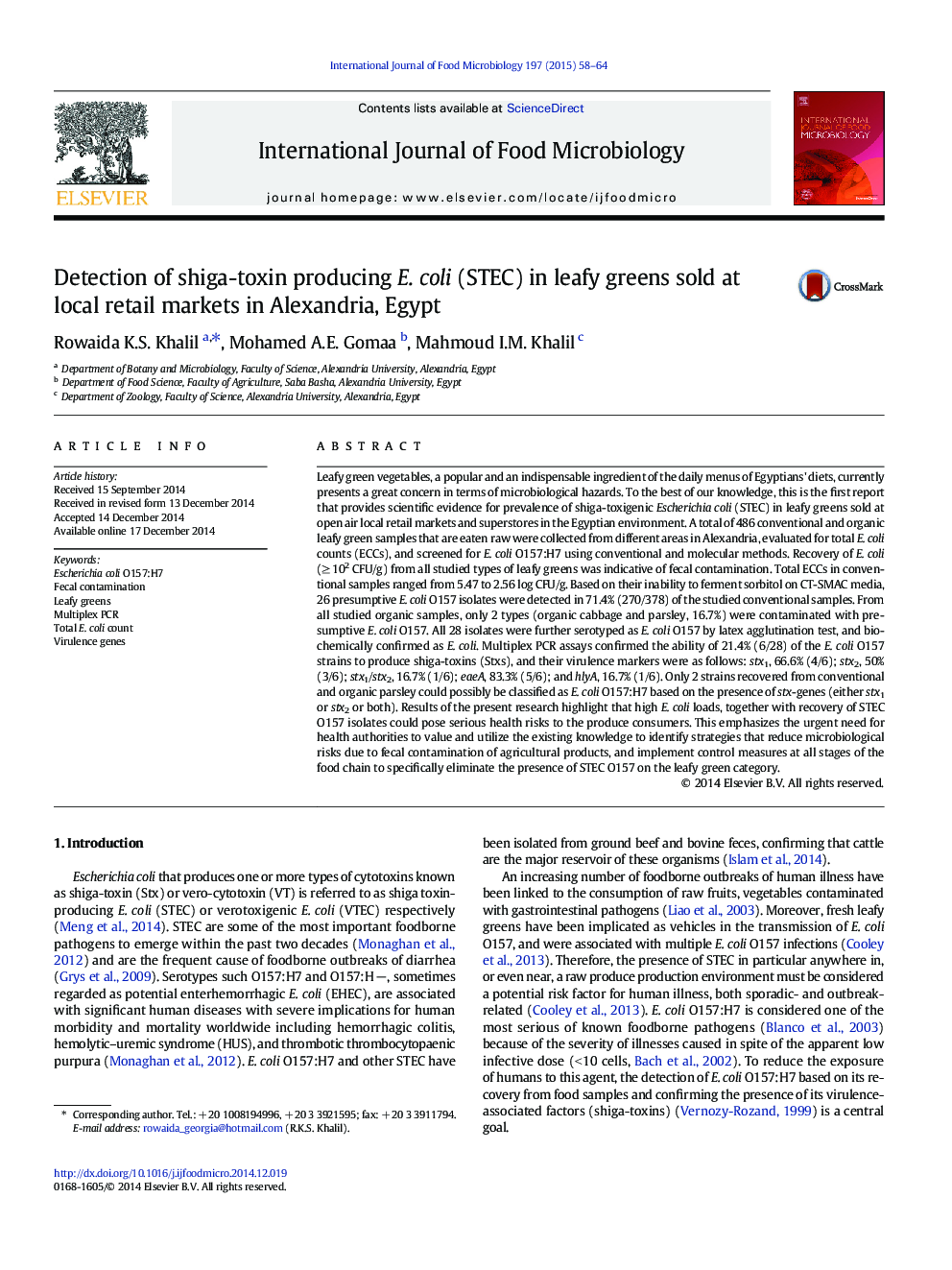| Article ID | Journal | Published Year | Pages | File Type |
|---|---|---|---|---|
| 4366672 | International Journal of Food Microbiology | 2015 | 7 Pages |
•A total of 486 conventional and organic leafy green samples grown in the Egyptian environments were surveyed for their microbial quality and screened for E. coli O157:H7. E. coli was recovered (≥ 102 CFU/g) from all studied types of leafy greens available at the time of sampling. All tested conventional greens were of unacceptable quality from the perspective of their mean ECC values. The overall microbial quality of the tested organic produce items was better than the corresponding conventional ones with regards to their significantly low contamination levels with the indicator bacteria.•The recovery rate of non-sorbitol fermenting O157 isolates from all conventional and organic leafy green samples was 2.5% (28/486). The highest prevalence levels of E. coli O157 isolates was recognized in cilantro samples (25.9%) and arugula (11.11%).•A multiplex PCR (6-gene) assay was optimized to generate satisfactory data on simultaneous detection of several virulence marker genes in 28 E. coli O157 isolates. The multiplex PCR assay confirmed the presence of stx1 and stx2 genes in 6 out of 28 (21.4%) strains. It was speculated that in terms of their shiga-toxin production, some O157 strains although not recovered from cases of human illnesses, can be of potential danger to human health. Definitive data about the clinical significance of these isolates should be provided through future research
Leafy green vegetables, a popular and an indispensable ingredient of the daily menus of Egyptians' diets, currently presents a great concern in terms of microbiological hazards. To the best of our knowledge, this is the first report that provides scientific evidence for prevalence of shiga-toxigenic Escherichia coli (STEC) in leafy greens sold at open air local retail markets and superstores in the Egyptian environment. A total of 486 conventional and organic leafy green samples that are eaten raw were collected from different areas in Alexandria, evaluated for total E. coli counts (ECCs), and screened for E. coli O157:H7 using conventional and molecular methods. Recovery of E. coli (≥ 102 CFU/g) from all studied types of leafy greens was indicative of fecal contamination. Total ECCs in conventional samples ranged from 5.47 to 2.56 log CFU/g. Based on their inability to ferment sorbitol on CT-SMAC media, 26 presumptive E. coli O157 isolates were detected in 71.4% (270/378) of the studied conventional samples. From all studied organic samples, only 2 types (organic cabbage and parsley, 16.7%) were contaminated with presumptive E. coli O157. All 28 isolates were further serotyped as E. coli O157 by latex agglutination test, and biochemically confirmed as E. coli. Multiplex PCR assays confirmed the ability of 21.4% (6/28) of the E. coli O157 strains to produce shiga-toxins (Stxs), and their virulence markers were as follows: stx1, 66.6% (4/6); stx2, 50% (3/6); stx1/stx2, 16.7% (1/6); eaeA, 83.3% (5/6); and hlyA, 16.7% (1/6). Only 2 strains recovered from conventional and organic parsley could possibly be classified as E. coli O157:H7 based on the presence of stx-genes (either stx1 or stx2 or both). Results of the present research highlight that high E. coli loads, together with recovery of STEC O157 isolates could pose serious health risks to the produce consumers. This emphasizes the urgent need for health authorities to value and utilize the existing knowledge to identify strategies that reduce microbiological risks due to fecal contamination of agricultural products, and implement control measures at all stages of the food chain to specifically eliminate the presence of STEC O157 on the leafy green category.
